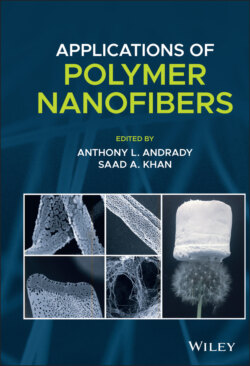Читать книгу Applications of Polymer Nanofibers - Группа авторов - Страница 48
2.5.2 Filter Fabrics
ОглавлениеNanofiber fabrics are characterized by high surface area and high absorptivity, which have been considered as important characteristics for air and water filtrations. Particularly, with the decrease of air quality, air filter media are getting more attention, such as dust masks, engine air filtration. The usage of nanofibers is a benefit for improving filtration efficiency because of their smaller pore size and larger surface collection area (Zhang et al. 2010).
Wang et al. prepared sandwiched electrospun polyimide (PI) nanofiber fabric between carbon woven fabrics, which was used as a filter of PM 2.5 particles (Wang et al. 2016). The sandwich structure is shown schematically in Figure 2.17. The filtration efficiency of the nanofiber‐based sandwich structure reached 99.99% for PM 2.5. Even after thermal treatment at 260 °C, it could still keep high filtration efficiency and maintained good mechanical properties.
Based on good air filtration properties, Li and coworker designed a gauze mask product to prevent inhaling PM 2.5 particles by using an electrospun polysulfone nanofiber fabric (Li and Gong 2015). The result indicated that the prepared nanofiber mask demonstrated a high rejected effect larger than 90% and acceptable air permeability which was probably due to the nanoscaled fiber size. Typically, the rejected effect and air permeability property could not be satisfied simultaneously. For instance, in some cases, in order to meet the requirement of rejected effect, the fabric in the mask would be thicker, which would affect the air permeability.
Moreover, researchers have blended additives in nanofiber fabrics to achieve specific effect in the process of filtrating. For example, Park and coworker added benzyl triethylammonium chloride as an antimicrobial agent into electrospun PVA nanofibers and then deposited them onto a commercial glassfiber fabric, for use as antimicrobial water filtration (Park and Kim 2017). The antimicrobial water filtration test demonstrates that the obtained fabric could improve the removal of different types of bacteria. Apart from electrospinning, the melt‐blown method could also be used to produce nanofiber fabrics for air filtration, which was much faster, easier, and cheaper. Hassan et al. investigated the die geometry and operating conditions of the melt‐blown process to prepare PP nanofiber nonwoven fabrics for use in air filtration field (Hassan et al. 2013). By using the melt blowing process, the production rate of nanofiber nonwoven fabrics with an average fiber diameter of around 330 nm was able to achieve 2.23 kg/h/m of die width. The experiments also showed that the fabric basis weight and the fiber size could be designed in this approach to achieve higher air permeability and higher filtration quality.
Figure 2.17 The structure of (a) three‐layered and (b) five‐layered PI nanofiber/carbon woven fabric composite filter, (c, d) diagram and digital photos of the composite filters.
Source: (a–d) Wang et al. (2016); (d) Reproduced with permission from Wang et al. (2016). Copyright 2016, Elsevier.
